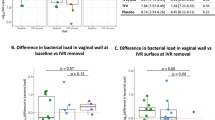Abstract
The epidemic of HIV has catalyzed the need for safe and effective prevention methods, particularly for women. Vaginal microbicides have been targeted because these methods can be controlled by women themselves. Microbicides have focused on preventing HIV as well as other sexually transmitted infections, because the acquisition of HIV is enhanced by the presence of many infections. Although many products show promise in preclinical trials, safety remains paramount. The importance of safety was exemplified by the nonoxynol-9 studies which showed actual harm. This experience catalyzed the development of criteria that should be used as safety standards in trials, including immune markers of the cervical epithelium, and colposcopy standards. Unfortunately, immune markers are in their infant stages of development and reliability and validity checks remain large challenges. There have been four recent phase IIb/III trials that had disappointing results. However, these trials offer an opportunity to develop new preclinical models and biomarkers. The search for new microbicides remains critical. Current microbicides in trials can be categorized into vaginal defense enhancers (which help maintain the vaginal pH or facilitate the colonization of vaginal lactobacilli); surfactants (or detergents) which disrupt viral membranes; HIV entry inhibitors; and HIV reverse transcriptase inhibitors. Even with a good product, acceptance by both partners will be essential for its success, and lack of acceptance is often not evident until large trials are completed.
Similar content being viewed by others
References
Van Damme L, Ramjee G, Alary M, Vuylsteke B, Chandeying V, Rees H, et al. Effectiveness of COL-1492, a nonoxynol-9 vaginal gel, on HIV-1 transmission in female sex workers: a randomised controlled trial. Lancet 2002;360:971–977.
Fichorova RN, Tucker LD, Anderson DJ. The molecular basis of nonoxynol-9-induced vaginal inflammation and its possible relevance to human immunodeficiency virus type 1 transmission. J Infect Dis 2001;184:418–428.
Hillier SL, Moench T, Shattock R, Black R, Reichelderfer P, Veronese F. In vitro and in vivo: the story of nonoxynol 9. J Acquir Immune Defic Syndr 2005;39:1–8.
Galen BT, Martin AP, Hazrati E, Garin A, Guzman E, Wilson SS, et al. A comprehensive murine model to evaluate topical vaginal microbicides: mucosal inflammation and susceptibility to genital herpes as surrogate markers of safety. J Infect Dis 2007;195:1332–1339.
van de Wijgert JH, Shattock RJ. Vaginal microbicides: moving ahead after an unexpected setback. AIDS 2007;21:2369–2376.
Lard-Whiteford SL, Matecka D, O’Rear JJ, Yuen IS, Litterst C, Reichelderfer P. Recommendations for the nonclinical development of topical microbicides for prevention of HIV transmission: an update. J Acquir Immune Defic Syndr 2004;36:541–552.
Smith JS, Robinson NJ. Age-specific prevalence of infection with herpes simplex virus types 2 and 1: a global review. J Infect Dis 2002;186(Suppl 1):S3–S28.
Schwartz JL, Mauck C, Lai JJ, Creinin MD, Brache V, Ballagh SA, et al. Fourteen-day safety and acceptability study of 6% cellulose sulfate gel: a randomized double-blind phase I safety study. Contraception 2006;74:133–140.
Taha TE, Hoover DR, Dallabetta GA, Kumwenda NI, Mtimavalye LA, Yang LP, et al. Bacterial vaginosis and disturbances of vaginal flora: association with increased acquisition of HIV. AIDS 1998;12:1699–1706.
Martin HL, Richardson BA, Nyange PM, Lavreys L, Hillier SL, Chohan B, et al. Vaginal lactobacilli, microbial flora, and risk of human immunodeficiency virus type 1 and sexually transmitted disease acquisition. J Infect Dis 1999;180:1863–1868.
Myer L, Denny L, Telerant R, Souza M, Wright TC Jr, Kuhn L. Bacterial vaginosis and susceptibility to HIV infection in South African women: a nested case-control study. J Infect Dis 2005;192:1372–1380.
Margolis L, Shattock R. Selective transmission of CCR 5-utilizing HIV-1: the “gatekeeper” problem resolved? Nat Rev Microbiol 2006;4:312–317.
Author information
Authors and Affiliations
Corresponding author
About this article
Cite this article
Moscicki, AB. Vaginal microbicides: where are we and where are we going?. J Infect Chemother 14, 337–341 (2008). https://doi.org/10.1007/s10156-008-0630-3
Received:
Published:
Issue Date:
DOI: https://doi.org/10.1007/s10156-008-0630-3




